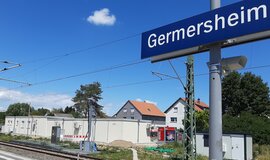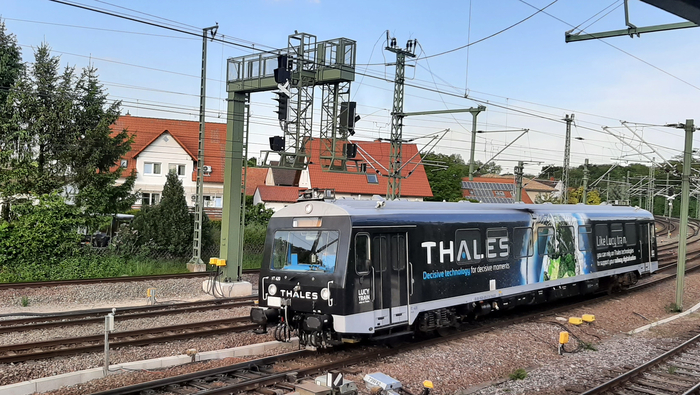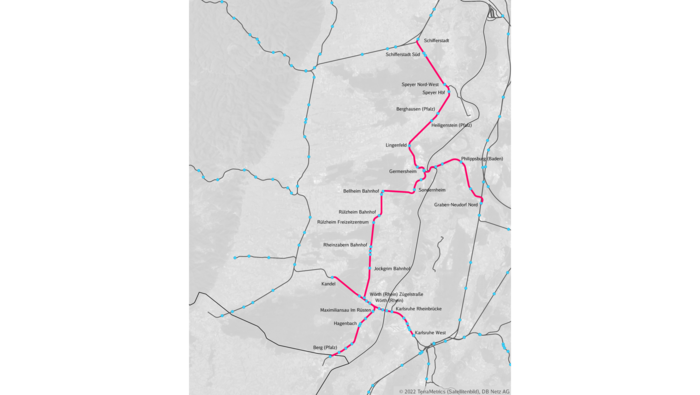
Digitalisation in Southern Germany: successful commissioning of the first section in the Wörth-Germersheim-Speyer project
Cables instead of levers: after just 1.5 years, new interlockings went into operation in Germersheim, Philippsburg and Rülzheim in the morning of 20 June – replacing (electro-)mechanical interlockings that work with lever technology. The commissioning marks the completion of the first construction section in the Wörth-Germersheim-Speyer project. Two more construction sections will be completed by the end of the year. At that time the whole interlocking and level crossing safety technology around Germersheim will be renewed.
Digitale Schiene Deutschland is making its way into Southern Germany: on the morning of 20 June, new central electronic interlocking (ESTW-Z: Elektronisches Stellwerk, Zentrale) was put into operation in the Rhineland-Palatinate town of Germersheim. Signallers now no longer use levers, but control trains around Germersheim digitally, at the click of a mouse. For example, they can now set the necessary points and signals to give the track warrant for a safe journey.
Also part of this section were two new interlocking modules in form of an ESTW-A (Elektronisches Stellwerk, Außeneinheit) in Philippsburg and Rülzheim. These are connected to the Germersheim interlocking and act as an interface to the signals and points in the area.
"Today is a huge success for our project and the region. In just 1.5 years, we’ve renewed the interlocking and level crossing safety technology in the first construction section. Other similar projects have taken much longer. This high pace was made possible by the Fast-Track Programme, an economic stimulus program created by the government, the rail industry and Deutsche Bahn."
Gabor von Wilmowski, Head of Realisation of Programmes and Projects, DSTW/ETCS project portfolio and Wörth-Germersheim-Speyer Project Manager
This project is one of seven projects in the €500 million Fast-Track Programme. In three construction sections, the (electro-)mechanical interlockings in Germersheim, Philippsburg and Wörth, the relay interlocking in Speyer and the block post in Rülzheim will be replaced by modern electronic interlockings.
The signalling and level crossing safety technology will also be renewed. From late 2022, signallers will control trains digitally from Germersheim along these routes:
- Schifferstadt - Speyer - Germersheim - Wörth - Lauterburg,
- Kandel - Karlsruhe,
- Germersheim - Rheinsheim and Rheinsheim - Graben-Neuendorf Nord.
The commissioning marks the completion of the first construction section in the Wörth-Germersheim-Speyer project, which comprised:
- Germersheim: a new 42 x 6 metre module building for the central ESTW (see main image), with three operator stations for signallers
- Germersheim station: 2 new signal brackets and 2 special signal constructions
- Philippsburg: a new 12 x 6 metre module building for the interlocking module
- Rülzheim: technology installed in the existing concrete distribution station
- Lingenfeld: modernised level crossing, points heating system renewed and new telecom systems installed
- 172 km new cabling
- 123 signals renewed
- 32 point machines renewed

Most of the construction work was carried out during day-to-day operations. However, before commissioning, the Speyer-Germersheim-Wörth and Germersheim-Philippsburg lines had to close for a short time – to complete construction work, deconstruct old systems and carry out the acceptance test of new ones. In addition, several new power supplies were added. Furthermore, the construction work was essentially carried out during ongoing operations.
"The aim was to keep the impact on passengers to a minimum. Most construction work took place during night-time closures and at weekends. This was a challenge that we mastered in close cooperation with our contractor, Thales Deutschland GmbH, taking into account the rapid speed and short lead time."
Gabor von Wilmowski, Head of Realisation of Programmes and Projects, DSTW/ETCS project portfolio and Wörth-Germersheim-Speyer Project Manager
One project ends, another begins: the construction sections merge seamlessly. The second section is a new interlocking module in Speyer, due to go into operation in autumn 2022. The third and final section is a new interlocking module in Wörth. Most construction work will be completed by the end of 2022. From then, the region will reap the benefits of modern interlocking and level crossing safety technology.
"More reliability in the rail network, less maintenance effort on the line, better control and more flexible train travel options: the Fast-track Programme is rapidly making the lines around Germersheim fit for a digital future."
Philipp Bockholt, Team Lead Communication & Public Relations, DSTW/ETCS project portfolio
The Wörth-Germersheim-Speyer project is the third overall commissioning of the Fast-track Programme, following Finnentrop and Kleve-Kempen.
